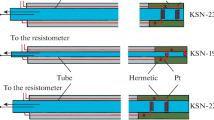Abstract
The resistive and capacitive properties of stainless-steel electrodes in contact with saline solutions of various concentrations were investigated over a frequency range extending from 20 to 10 kHz by using a variable-length conductivity cell. With a low current density, the series-equivalent resistance and capacitance of a single electrode-electrolyte interface were found to vary almost inversely as the square root of frequency. In the frequency range studied, it was found that the reactance was very nearly equal to the resistance and both varied almost inversely as the square root of the frequency, verifying Warburg's postulate. When current density was increased, resistance decreased and capacitance increased at all frequencies studied; the change in each was most apparent in the low frequency region. As a consequence, it can be stated that the impedance of an electrode-electrolyte interface decreases with increasing current density.
Sommaire
Les propriétés résistives et capacitives des électrodes inoxydables en contact avec des solutions salines de concentrations variées, ont été investiguées sur une rangée de fréquences s'étendant de 20 jusqu'à 10 kHz, en utilisant une cellule de conductivité de longueur variable. Avec une densité basse de courant, la résistance et la capacitance équivalente de séries, d'une seule interface de l'électrode-électrolyte ont été trouvées de varier presque inversement à la racine carrée de la fréquence, Dans la rangée de fréquences étudiées, on a trouvé que la réactance était presque égale à la résistance et les deux ont varié presque inversement, comme la racine carrée de la fréquence, vérifiant ainsi le postulat de Warburg. Quand la densité du courant fût augmentée, la résistance décrût et la capacitance augmenta dans toutes les fréquences étudiées; le changement dans chaque fréquence était le plus apparent dans la région basse de fréquence. Par conséquent, on peut affirmer que l'impédance d'une interface électrode-électrolyte décroît avec la densité croissante du courant.
Zusammenfassung
Es wurden die Widerstands- und Kapazitätseigenschaften von Elektroden aus rostfreiem Stahl in Kontakt mit Salzlösungen verschiedener Konzentrationen über einem Frequenzbereich von 20 bis zu 10 kHz bei Verwendung von einer Leitfähigkeitzelle mit veränderlicher Länge untersucht. Es wurde festgestellt, dass mit einer niedrigen Stromdichte Reihenäquivalent von Widerstand und Kapazität einer Einzelelektroden-Elektrolytengrenzfläche sich beinahe umgekehrt mit der Quadratwurzel der Frequenz ändert. Es wurde bei dem untersuchten Frequenzbereich festgestellt, dass die Reaktanz fast ganz gleich dem Widerstand war, und dass beide sich fast umgekehrt mit der Quadratwurzel der Frequenz änderten und Warburg's Grundbedingung bestätigten. Wenn die Stromdichte vergrössert wurde, nahm der Widerstand ab und die Kapazität nahm bei allen untersuchten Frequenzen zu. Die Änderung in Beiden war am meisten im niedrigen Frequenzbereich bemerkbar. Es kann somit behauptet werden, dass die Impedanz einer Elektroden-Elektrolytengrenzfläche mit zunehmender Stromdichte abnimmt.
Similar content being viewed by others
References
Feates, F. S., Ives, D. J. G. andPryor, J. H. (1956) Alternating current bridge for measurement of electrolytic conductance.J. electrochem. Soc. 103, 508–585.
Fricke, H. (1932) The theory of electrolyte polarization.Phil. Mag. 14, 310–318.
Geddes, L. A. andBaker, L. E. (1966) The relationship between input impedance and electrode area in recording the ECG.Med. biol. Engng 4, 439–450.
Geddes, L. A., Baker, L. E. andMcGoodwin, M. (1967) The relationship between electrode area and amplifier input impedance in recording muscle action potentials.Med. biol. Engng 5, 561–569.
Gouy, M. (1910) Sur la constitution de la charge électrique a la surface d'un electrolyte.J. Phys. 9, 457–468.
Grahame, D. G. (1952) Mathematical theory of the faradic admittance.J. electrochem. Soc. 9, Suppl. C, 370–385.
Grundfest, H. andCampbell, B. (1942) Origin, conduction and termination of impulses in dorsal spinocerebellar tracts of cats.J. Neurophysiol. 5, 275–294.
Grundfest, H., Sengstaken, R. W. andOettinger, W. H. (1950) Stainless steel micro-needle electrodes made by electro-pointing.Rev. scient. Instrum. 21, 360–361.
Helmholtz, H. (1879) Studien über electrische Grenzschichten.Ann. Phys. Chem. 7, 337–382.
Hubel, D. H. (1957) Tungsten microelectrode for recording from single units.Science 125, 549–550.
Jaron, D., Briller, S. A., Schwan, H. P. andGeselowitz, D. B. (1969) Nonlinearity of cardiac pacemaker electrodes.IEEE Trans. bio-med. Engng 16, 132–138.
Robinson, R. A. andStokes, R. H. (1959)Electrolyte Solutions. Academic Press, New York.
Schwan, H. P. (1963) Determination of biological impedances. In:Physical Techniques in Biological Research (Ed.Nastuk, W.). Academic Press, New York.
Schwan, H. P. (1965) Electrode polarization in AC steady state impedance of biological systems.Digest 6th Int. Conf. med. Elect. biol. Engng (Tokyo). Paper 33-1.
Schwan, H. P. andMaczuk, J. G. (1965) Electrode polarization impedance; limits of linearity.Proc. 18th Ann. Conf. engng Biol. Med., Philadelphia. McGregor & Werner, Washington, D C.
Schwan, H. P. (1968) Electrode polarization impedance and measurements in biological materials.Ann. N.Y. Acad. Sci. 148, 191–209.
Stern, O. (1924) Zur Theorie der elektrolytischen Doppelschicht.Z. Elektrochem. 30, 508–516.
Varley, C. F. (1871) Polarization of metallic surfaces in aqueous solutions.Proc. R. Soc. 19, 243–246.
Warburg, E. (1899) Über das Verhalten sogenannter unpolarisirbarer Elektroden gegen Wechselstrom.Ann. Phys. Chem. 67, 493–499.
Warburg, E. (1901) Über die Polarizationscapacitat des Platins.Ann. Phys. 6, 125–135.
Wein, M. (1896) Über die Polarization bei Wechselstrom.Ann. Phys. Chem. 58, 37–72.
Weinman, J. andMahler, J. (1964) An analysis of electrical properties of metal electrodes.Med. Electron. biol. Engng 2, 299–310.
Author information
Authors and Affiliations
Rights and permissions
About this article
Cite this article
Geddes, L.A., Da Costa, C.P. & Wise, G. The impedance of stainless-steel electrodes. Med. & biol. Engng. 9, 511–521 (1971). https://doi.org/10.1007/BF02474708
Received:
Issue Date:
DOI: https://doi.org/10.1007/BF02474708




